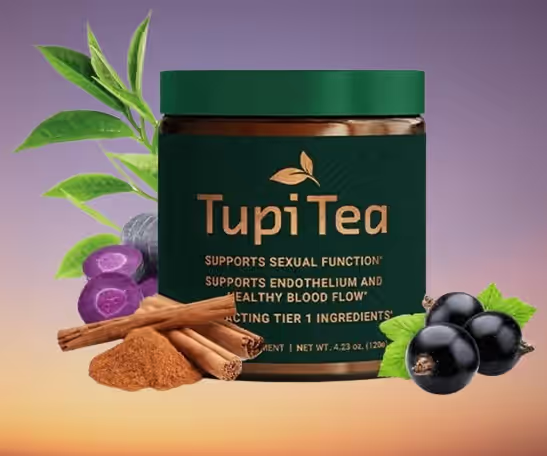Table of Contents
Ever wondered what makes hojicha tea different from your usual green tea? It’s a common question, and honestly, there’s a lot more to it than just the color. We’re talking about everything from how they’re made to how they taste, and even their caffeine levels. If you’re curious about the real scoop on hojicha tea vs green tea, you’re in the right place. Let’s break it all down.
Key Takeaways
- Hojicha is a roasted green tea, which changes its color, flavor, and caffeine content compared to unroasted green teas.
- The roasting process gives hojicha a distinctive brown color and a toasty, nutty taste, unlike the fresh, grassy notes of traditional green tea.
- Hojicha typically has less caffeine than other green teas because of the roasting process and often uses mature tea leaves and stems.
- While both teas offer health benefits, their unique compounds and processing methods mean they contribute to wellness in slightly different ways.
- Brewing methods and serving suggestions vary for hojicha and green tea to best bring out their individual characteristics.
Understanding Hojicha Tea
What is Hojicha Tea?
Hojicha is a japanese tea type that stands out from other green teas because of its unique roasting process. This roasting gives the tea leaves a distinctive brown color, setting it apart from the vibrant green hues of traditional green teas. It’s often enjoyed for its mild flavor and lower caffeine content, making it a popular choice for those sensitive to caffeine or looking for a relaxing evening beverage. Hojicha can be found in loose leaf or powdered form, offering versatility in preparation.
The History of Hojicha Tea
The story of Hojicha begins in Kyoto, Japan, in the 1920s. A tea merchant, seeking to make use of leftover tea leaves and stems, decided to roast them over charcoal. This experiment resulted in a surprisingly delicious and aromatic tea, which quickly gained popularity. Today, Hojicha is enjoyed not only in Japan but also worldwide, often used as a base for lattes and other creative drinks. It’s a testament to innovation and resourcefulness in the world of tea.
Hojicha Tea’s Unique Flavor Profile
The hojicha flavor profile is characterized by its toasty and nutty notes, a result of the roasting process. Unlike the grassy or vegetal flavors often associated with green tea, Hojicha offers a warm, comforting taste with hints of caramel. The roasting process also brings out a natural sweetness in the tea leaves, making it a delightful and satisfying beverage. The difference between hojicha and bancha lies in the processing; while both can be used, hojicha undergoes roasting, giving it that signature taste.
Hojicha’s appeal lies in its gentle flavor and aroma, making it an accessible tea for both seasoned tea drinkers and newcomers. Its low caffeine content further enhances its suitability as an everyday beverage, enjoyed at any time of day.
Here’s a quick comparison of Hojicha with other teas:
- Hojicha: Roasted, nutty flavor, low caffeine.
- Matcha: Powdered, umami flavor, high caffeine. The difference between hojicha and matcha is significant in both taste and preparation.
- Green Tea (Sencha): Grassy flavor, moderate caffeine.
Considering hojicha benefits? It’s known for its relaxing properties and antioxidant content, making it a healthy and enjoyable choice. The roasted tea explained is a simple process that transforms the tea leaves, creating a unique and beloved beverage.
👉 Discover the Best Roasted Hojicha Tea Experience Today 👈
Production Differences in Green Tea
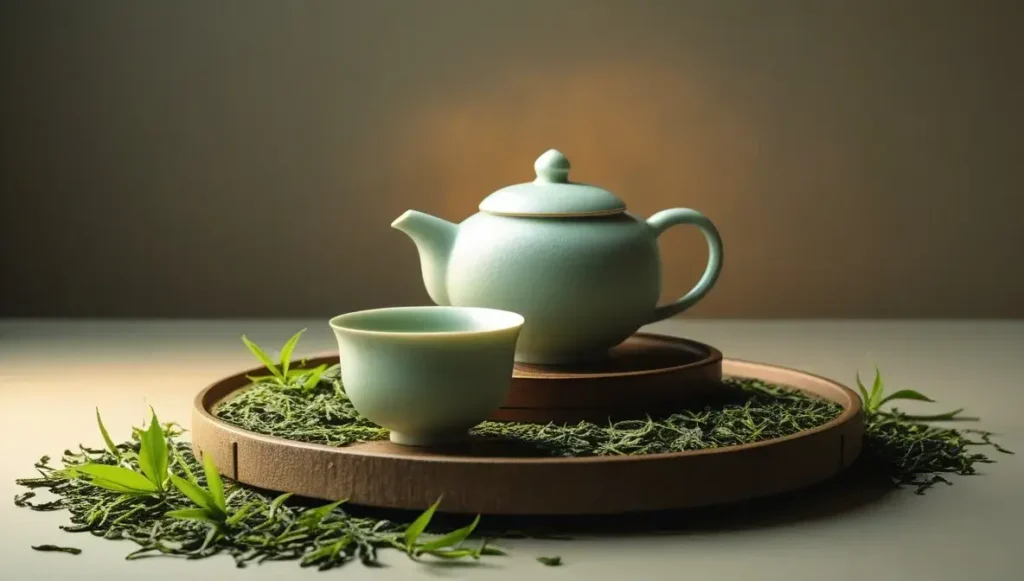
Roasting Process for Hojicha Tea
Hojicha stands out because it’s roasted green tea, unlike most types of japanese green tea that are steamed. This roasting is usually done in a pan over charcoal, though some producers use electric roasters. The temperature and duration of roasting are key; they determine the final color and flavor profile. The process reduces bitterness and creates the distinctive roasted green tea taste.
Traditional Green Tea Processing
Traditional green tea processing typically involves steaming the freshly harvested leaves to prevent oxidation. After steaming, the leaves are rolled and dried. This process preserves the green color and many of the tea’s natural compounds. Different green tea varieties undergo slight variations in these steps, influencing their final flavor and aroma. For example, Gyokuro is shaded before harvest, while Sencha is grown in full sunlight.
Impact of Processing on Tea Characteristics
The way green tea is processed has a huge impact on its characteristics. Steaming preserves the vibrant green color and grassy notes, while roasting, as done with Hojicha, creates a reddish-brown hue and toasty flavor. The heat from roasting also reduces the caffeine content. The green tea varieties compared show that processing methods are crucial in defining the tea’s unique qualities. The roasted tea comparison with steamed teas highlights these differences.
The roasting process not only changes the flavor but also alters the chemical composition of the tea leaves. This can affect the levels of antioxidants and other beneficial compounds, making each green tea varieties unique.
Color and Appearance of Teas
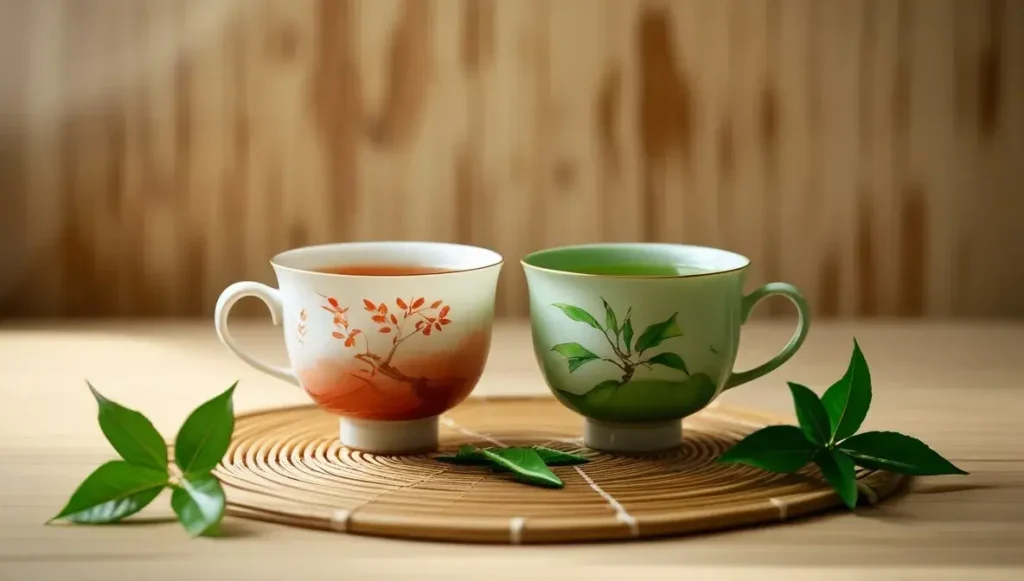
Hojicha Tea’s Distinctive Brown Hue
Hojicha tea is known for its unique reddish-brown color, which sets it apart from other Japanese green teas. This color comes from the roasting process that the tea leaves undergo. The specific shade can vary based on a few things, like how long the tea was roasted, when it was picked, and where it’s from. You might see anything from a light tan to a deeper, richer brown.
Vibrant Green of Traditional Green Tea
Traditional green tea, unlike hojicha, is famous for its vibrant green color. This color is due to the high chlorophyll content in the leaves, which are carefully steamed or pan-fired to prevent oxidation. The exact shade of green can tell you a lot about the tea. A bright green usually means a high-quality tea, while a duller green might mean it’s an older or lower-grade tea.
Factors Influencing Tea Color
Several things affect the color of tea, including:
- Processing methods: Steaming, pan-firing, and roasting all change the color.
- Harvest time: Younger leaves often have a brighter color.
- Oxidation levels: More oxidation leads to darker colors.
The color of tea isn’t just about looks; it can also give you clues about its flavor and quality. For example, a deeply roasted hojicha will likely have a bolder, smokier flavor than a lightly roasted one. Similarly, a bright green tea often has a fresher, more vegetal taste.
👉 Grab Your Top-Rated Green Tea Today and Feel Refreshed 👈
Caffeine Content in Hojicha Tea vs Green Tea
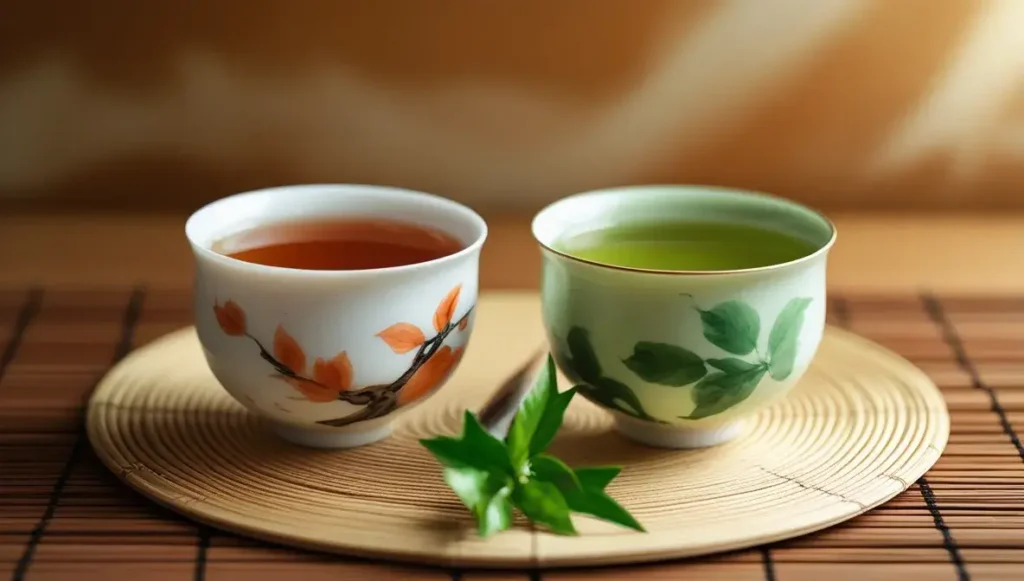
Lower Caffeine in Hojicha Tea
Hojicha is often praised for its lower caffeine content compared to other green teas. This makes it a great choice for those sensitive to stimulants or who want a relaxing evening drink. But why is there less caffeine in hojicha? It’s not just the roasting process, although that plays a small role. The primary reason is that hojicha is typically made from bancha, a later harvest of tea leaves, or even stems and stalks, which naturally contain less caffeine than the younger leaves used for teas like sencha or gyokuro.
Caffeine Levels in Green Tea Varieties
Different types of green tea have varying levels of caffeine. For example, gyokuro, a shade-grown green tea, can have relatively high caffeine levels. Sencha, another popular green tea, also contains a significant amount of caffeine. Hojicha, on the other hand, generally has much less. Here’s a quick comparison:
| Tea Type | Caffeine Content (approximate) |
|---|---|
| Gyokuro | High |
| Sencha | Moderate to High |
| Hojicha | Low |
It’s important to remember that brewing methods also affect the amount of caffeine in your cup. Hojicha is often brewed with cooler water and for shorter times, which extracts less caffeine compared to the hotter, longer steeping times used for some green teas.
Benefits of Reduced Caffeine
The lower caffeine in hojicha offers several benefits.
- It’s suitable for drinking later in the day without disrupting sleep.
- It’s a good option for individuals who are caffeine sensitive.
- It can be enjoyed by children and the elderly in moderation.
While caffeine has its own benefits, such as increased alertness, many people prefer to limit their intake. Choosing hojicha allows you to enjoy the health benefits and delicious flavor of green tea without the jitters. The reduced caffeine in hojicha makes it a versatile and enjoyable tea for any time of day.
Flavor Profiles and Taste Notes
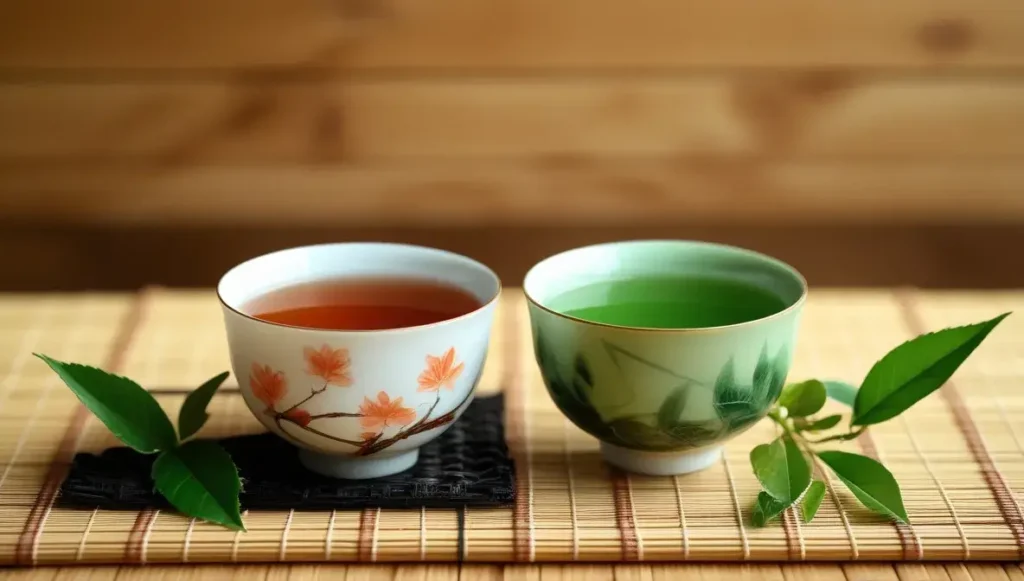
Toasty and Nutty Notes of Hojicha Tea
Hojicha tea is pretty different from your typical green tea, and that’s mostly because of how it’s processed. The roasting process really changes the flavor. Instead of the grassy taste you might expect, you get something way more toasty and nutty. It’s almost like drinking a warm, comforting hug. I’ve found that the exact flavor can depend on the roasting level; some are more subtly nutty, while others have a bolder, almost caramel-like taste. It’s a great option if you want something without a strong, bitter edge.
Grassy and Umami of Green Tea
Green tea, on the other hand, is all about that fresh, grassy flavor. Think of it like a freshly cut lawn, but in a good way! You also get this savory, umami thing going on, which adds a nice depth. It’s not always easy to describe, but it’s what makes green tea so satisfying. The taste can vary a lot depending on the type of green tea. For example, sencha tends to be brighter and more grassy, while matcha has a richer, more intense umami flavor. I personally love the clean, refreshing taste of a good green tea, especially in the afternoon.
Sweetness and Body Comparisons
When it comes to sweetness and body, hojicha and green tea are quite different. Hojicha often has a natural sweetness that comes out during the roasting process. It’s not like adding sugar, but more of a subtle, inherent sweetness that makes it really pleasant to drink. The body is usually lighter, making it a good choice if you want something easy to sip on.
Green tea can have some sweetness too, but it’s often balanced by a bit of astringency or bitterness. The body can range from light to full, depending on the type. For example, a fukamushi sencha (deep-steamed sencha) will have a fuller body compared to a regular sencha. It really comes down to personal preference, but I find hojicha to be a bit more consistently sweet and light-bodied.
I’ve noticed that the water temperature and steeping time can really affect the taste of both hojicha and green tea. If the water is too hot or you steep it for too long, you’re more likely to get a bitter taste. Experimenting with different brewing methods can help you find the perfect balance and bring out the best flavors in each tea.
👉 Unlock the Premium Taste of Top Hojicha Tea Now 👈
Health Benefits of Hojicha Tea and Green Tea
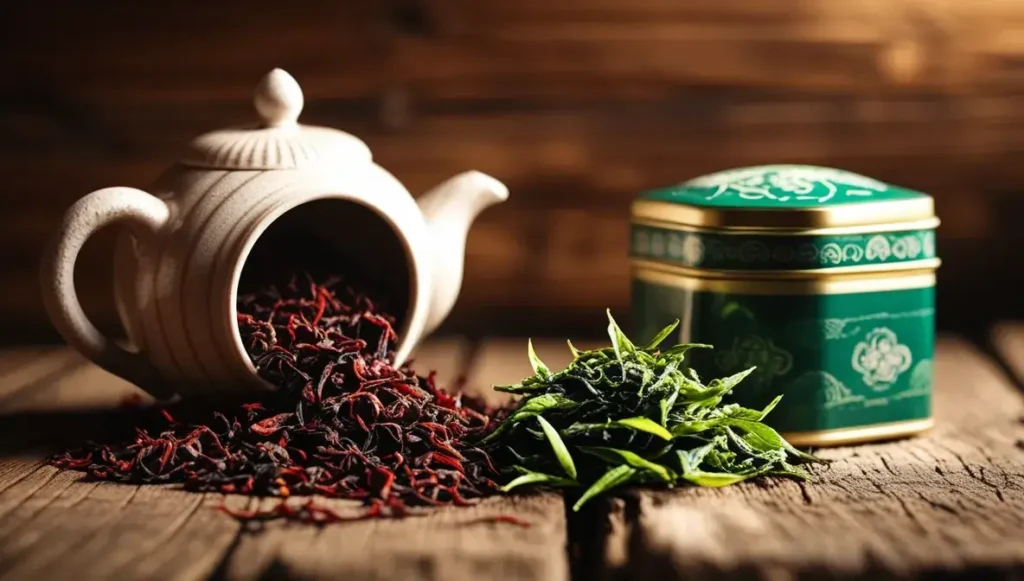
Antioxidant Properties in Both Teas
Both hojicha and green tea boast antioxidant properties, though to varying degrees. Green tea is celebrated for its high levels of catechins, powerful antioxidants linked to protecting against cell damage, heart issues, and more. However, the roasting process that creates hojicha can reduce some of these catechins.
- Green tea is rich in catechins.
- Hojicha contains antioxidants, though potentially fewer catechins.
- Antioxidants help combat cell damage.
Unique Compounds in Hojicha Tea
While hojicha might have fewer catechins than its unroasted counterpart, it’s not without its own unique benefits. The roasting process can actually create new compounds, such as pyrazines, which contribute to hojicha’s distinctive aroma and may offer some anti-inflammatory effects. It’s important to remember that the health benefits of tea extend beyond just one type of antioxidant.
Hojicha offers a sensory experience that goes beyond nutritional charts. Its low bitterness and mellow character make it a perfect evening tea, especially for those who want to avoid the stimulating effects of caffeine.
Overall Wellness Boost from Tea
Drinking tea, whether it’s hojicha or green tea, can be a part of a healthy lifestyle. While green tea is often touted for its high antioxidant content, hojicha health benefits should not be overlooked. The key is balance and enjoying a variety of teas to reap a broader range of benefits. More research is always developing, and as more studies come out, who knows what incredible things will be discovered about hojicha health benefits? Ultimately, both teas contribute to overall wellness in their own ways, offering a comforting and healthful beverage option. The roasted green tea benefits are unique and can be part of a balanced diet.
Brewing and Serving Suggestions
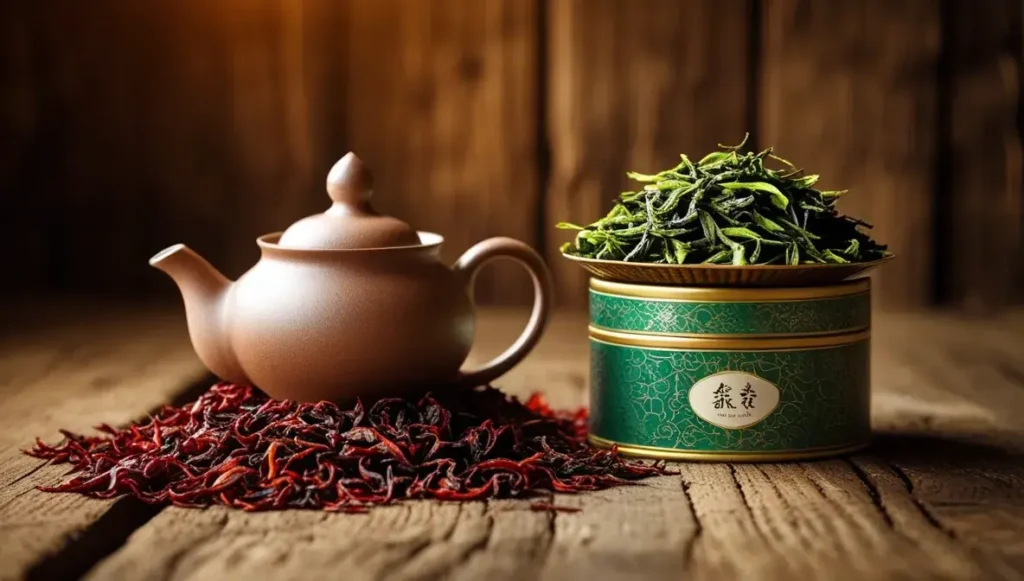
Optimal Brewing for Hojicha Tea
Okay, so you’ve got some hojicha. Now what? The good news is, it’s pretty forgiving. Unlike some green teas that demand specific temperatures and times, hojicha is a bit more laid-back. I usually go for water that’s around 175-185°F (80-85°C). You don’t want boiling water, or you might end up with a bitter taste. Steep it for about 30 seconds to a minute for the first infusion. You can totally re-steep hojicha multiple times, just increase the steeping time a bit with each go-around. I’ve found that the second and third infusions can be just as flavorful, if not more so, than the first.
Preparing Traditional Green Tea
Green tea can be a little trickier than hojicha, but don’t let that scare you! Water temperature is key here. Aim for around 170-180°F (77-82°C). Again, avoid boiling water. The steeping time depends on the type of green tea. For sencha, I usually steep for about a minute. For gyokuro, which is a higher-grade green tea, you might want to go a bit shorter, like 45 seconds. And just like hojicha, you can re-steep green tea. The first infusion is often the most intense, while subsequent infusions can be more subtle and nuanced.
Hojicha Tea in Lattes and Other Drinks
This is where things get fun! Hojicha lattes are seriously delicious. I like to use about a teaspoon of hojicha powder per cup of milk (dairy or non-dairy, whatever you prefer). Whisk it together until it’s nice and frothy. You can add a little sweetener if you want, but I usually find it’s good on its own. Besides lattes, hojicha is also great in iced tea, smoothies, and even baked goods. I’ve seen recipes for hojicha ice cream and hojicha-flavored cakes. The possibilities are endless!
Experiment! Don’t be afraid to play around with different brewing times, water temperatures, and serving suggestions. The best way to find what you like is to try things out and see what works for you. Tea is meant to be enjoyed, so have fun with it!
Here’s a quick guide to get you started:
- Hojicha Latte: 1 tsp hojicha powder, 1 cup milk, sweetener (optional)
- Iced Hojicha Tea: Brew hojicha as usual, let it cool, and pour over ice.
- Green Tea Smoothie: Add a teaspoon of matcha to your favorite smoothie recipe.
👉 Experience Top-Quality Green Tea and Elevate Your Day 👈
Conclusion: Picking Your Perfect Brew
So, we’ve talked a lot about hojicha and regular green tea. It really comes down to what you like and what you’re looking for in a drink. If you want something light and fresh, with that classic green tea taste, then the usual green tea is probably your go-to. But if you’re after something a bit different, maybe a little nutty and cozy, especially if you’re trying to cut back on caffeine, then hojicha is definitely worth a try. Both are great, just in their own ways. So, go ahead and try them both to see which one fits your mood best!
Frequently Asked Questions
What makes Hojicha different from other green teas?
Hojicha is a special type of Japanese green tea. What makes it different is that it’s roasted after it’s picked, which gives it a unique flavor and a brownish color. Most other green teas are steamed or pan-fired, keeping their green color.
Does Hojicha have a lot of caffeine?
Hojicha has less caffeine than most other green teas. This is because of the roasting process, which naturally reduces the caffeine content. It also often includes parts of the tea plant like stems and twigs, which are lower in caffeine to begin with. This makes it a good choice for people who want to cut down on caffeine.
What does Hojicha taste like?
Hojicha tastes warm and cozy, with a nutty and toasty flavor. It often has hints of caramel and a natural sweetness. It’s not bitter like some green teas can be, and it has a smooth, rich feel in your mouth.
Why is Hojicha brown instead of green?
Hojicha gets its brownish color from being roasted at high temperatures. This process changes the color of the tea leaves, making them look more like black tea than green tea.
How do I make Hojicha tea?
You can brew Hojicha by using about one teaspoon of tea leaves for every six ounces of water. Heat the water until it’s steaming but not boiling, around 175 degrees Fahrenheit. Let the tea steep for about three minutes. Using a teapot or infuser helps the leaves open up and give more flavor.
Is Hojicha good for your health?
Yes, Hojicha has health benefits! Like other teas, it contains antioxidants that are good for your body. While it has less caffeine, the roasting process can create new helpful compounds. It’s a comforting drink that can be part of a healthy lifestyle.
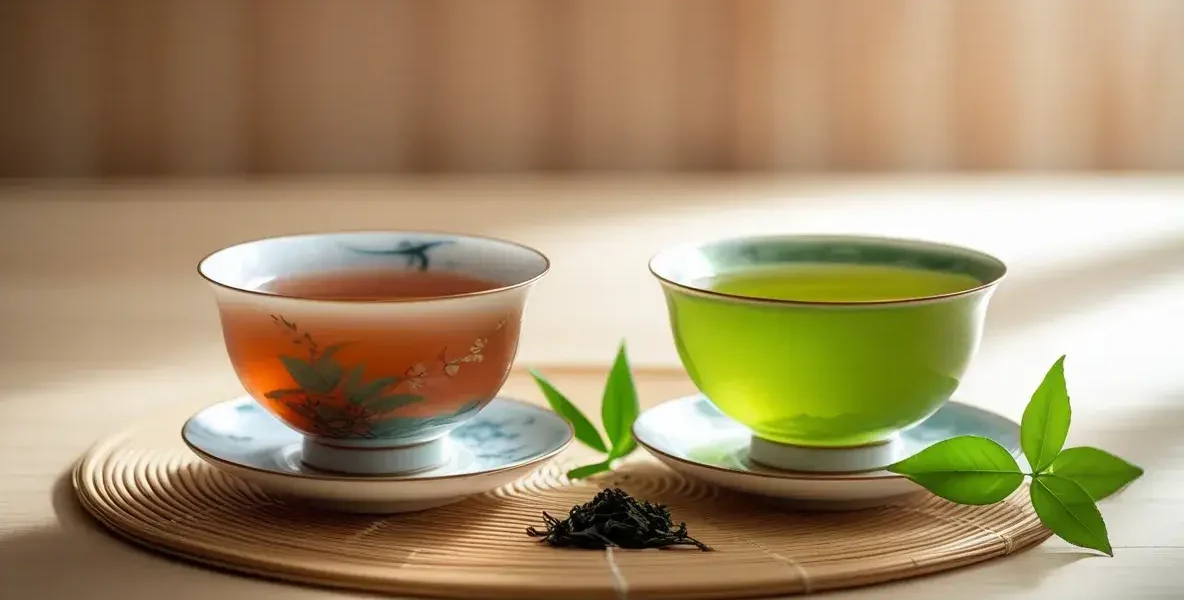

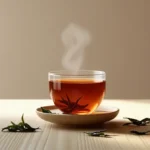
![Jasmine Tea vs Green Tea Benefits: Which Gives Better Health Results? [2025] jasmine tea vs green tea benefits](https://www.goteaworld.com/wp-content/uploads/2025/09/jasmine-tea-vs-green-tea-benefits-150x150.webp)



![Pu Erh Tea vs Green Tea: Which is Better for Daily Health? [2025] pu erh tea vs green tea](https://www.goteaworld.com/wp-content/uploads/2025/10/pu-erh-tea-vs-green-tea-150x150.webp)





